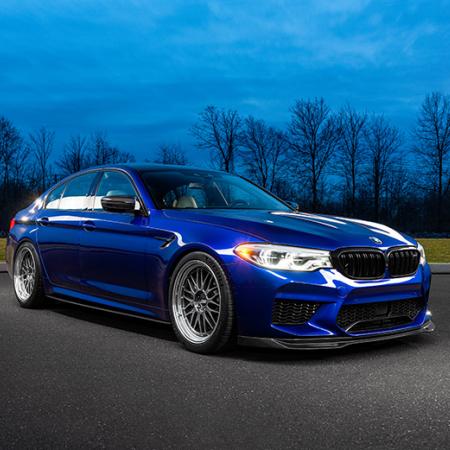 The purchase of Car #13 was spawned in a most unexpected way—incubated during two days of frigid weather over the long Presidents Day weekend. On the first day, I spent virtually the entire day on Craigslist, just to have something to do in a warm house. It was during this marathon that I found the car. And on the second, I went out in frigid temps and bought it.
The purchase of Car #13 was spawned in a most unexpected way—incubated during two days of frigid weather over the long Presidents Day weekend. On the first day, I spent virtually the entire day on Craigslist, just to have something to do in a warm house. It was during this marathon that I found the car. And on the second, I went out in frigid temps and bought it.
And the car itself, potentially a new daily driver, is rather unexpected as well.
But, since I am a fellow to whom context is everything, we need to back up. Readers of this space surely know the basic elements of the back story; I sold my E46 325xi wagon last year and resolved to get through the winter by tag-teaming the crap-can Suburban and the Z3. Then the ’Burb blew out its brake lines, and for over a month the Z3 was the only game in town. This worked because the early part of winter in Boston was mercifully and unseasonably warm; I drove the Z3 with its top down well into December.
When winter’s bill came due, the Suburban was, fortunately, back on the road. And let’s face it: To those of us who wrench, there are few things that feel better than rescuing a vehicle from the jaws of donation to public television and helping it continue to live a purposeful existence. It felt good driving the truck in the salty stuff. And, with gas at only a buck-sixty a gallon, it even made sense. But in spite of my odd attachment to the truck, it is an utter shitbox. And when the roads are dry, driving it does get old.
The fundamental problem with the concept of tag-teaming the ’Burb and the Z3 is that it is, at its core, a bad idea.
The Z3, for all its charm, is simply a terrible winter car. The idea was to drive the ’Burb when it’s sleazy out and use the Z3 when the roads are clear (although it does have snows on it, just in case). But snow notwithstanding, when it’s really cold out, there’s so much heat loss through the Z3’s cloth top that it never really gets warm in the car. And the rear visibility through the plastic window is poor (yes, I know I can use that plastic cleaning compound). And the ’Burb will, at some point in the not too distant future, die again and not be worth fixing again. If it dies on my seven-mile commute along local roads, no big deal; but I am hesitant to rely on it for longer jaunts.
But that’s only the superficial context. There’s something deeper going on.
In my last few Roundel magazine columns, I’ve been hard on BMW, saying that BMW’s design language completely lost me years ago, that I’ve got zero lust for the newer cars, that I’m turned off by the level of complexity, that I don’t want to take the financial risk of owning one at the point in its lifecycle at which I usually purchase cars—lots of miles and long out of warranty—and that I don’t want to put the time into dealing with things like turbos and electric water pumps and coded modules myself.
For these reasons, I made a practical and philosophical decision to not buy an E91 wagon to replace the E46 wagon. This resulted, for the first time in 34 years, in my not daily-driving a BMW. I get defensive about this, puffing up my chest and pointing out that I still own nine BMWs and don’t have to prove anything to anybody.
Except, perhaps, to myself.
Now, all of that actually had nothing whatsoever to do with why I was looking for a car on Sunday, and had little to do with why I bought one on Monday (Presidents Day), at least not initially. On Sunday it was literally two degrees outside in Boston. To continue with the air-conditioning work on the E30 I wrote about last week, I needed to finish blowing out the lines and components, and that is smelly work for which the garage door needs to be open, which—well, you see the problem.
So: Craigslist. Most of Sunday. Just because I could, and because I easily slip into this mode where I can reflexively burn hours doing it: regular CL in Boston. CL using the “search nearby cities” option. Searching for 2002s, E3s, and E9s by using the year range. Searching for BMW wagons. 318tis. E36 M3/4/5s. Setting CL to search for manual transmission only, then sorting by lowest price, and seeing what pops up (great way to find stuff, by the way). Switching back to all transmissions to look for cheap 750iLs and 850i’s. Switching from CL to Searchtempest to search nationally for stupid stuff: ’63 Rambler Ambassadors with V8s, power everything, and factory air. Europas. TVR 2500Ms. Vanagon campers. Vixens with BMW turbodiesel engines.
God help me, Triumph GT6s.
It was a wonderful and utterly relaxing way to burn an entire day. With the frigid outdoor temperatures, it even seemed to generate its own heat. At some point, I started to play a game: How cheaply could I buy an E39 540i six-speed and use it as a winter beater (or, as we say in Boston, a “wintah beatah”)? Those 4.4-liter V8 cars have a reputation as the cheapest way to drive 155 mph, at least until the timing-chain guides go, the cooling system craps out, and the maintenance costs to do the valley-pan gasket and the front-end bushings eat you alive.
So I searched—locally. Because in this game, you’re not going to ship a car. (Hey, my game, my rules.) I walked up the learning curve of early and late E39 540is. I tried to understand the Byzantine nature of the term “sport package,” the contents of which vary by year. It appears that all six-speeds were sport-package cars, even the early ones with chrome window trim, but in general, it’s the black Shadowline trim around the windows that easily identifies the sport-package cars. Ingredients also included a lowered M sport suspension, special wheels, three-spoke M steering wheel and M shift knob, and, depending on the year, other M-labeled bits like door sills. Later sport package cars may also have sport seats.
I also learned that there was an additional 540i M Sport package (sometimes called M-Tech Sport), option code 337, which existed in the U.S. in 2003 only, and has the M suspension II (option code 705), the M5 aerodynamic package (option code 715), staggered eighteen-inch M Parallel wheels (option code 780), and other goodies. I learned that many sport-package cars are advertised incorrectly as “M Sport” cars simply because they have the M steering wheel and shift knob, and the seller either doesn’t know that doesn’t make it an M Sport, or is intentionally trying to mislead buyers. I learned how to tell what’s what by getting the VIN and running it through BMW VIN Decoder (Google it), where you can look at how the car was actually optioned from the factory.
In the end, it appeared that two grand would buy me any of several local 2001–2003 540i Sports that immediately needed timing-chain guides, or an early car with 300K on the body and 80K on a replacement engine.
And that was that for my game. On to something more fruitful, like searching for the ’69 Plymouth Satellite I learned to drive on.
But then I began to see something I’d never thought about: the 540i’s quieter, more polite little brother, the 530i. And that rang a bell.
Charlie Burke, with whom I work at Bentley Publishers—he writes most of the Bentley manuals—has said for years that a late 530i is a great car. It’s a six—the three-liter 225-horsepower M54, the same engine that’s in the E46 330i, with 32 horsepower more than my old 528i wagon—that doesn’t have the reliability and maintenance issues of the V8. And, as with any car, by the end of the E39’s production run, improvements had been made, and bugs had been worked out. Bimmer’s E39 Buyer’s Guide says, “The 530i sedan is unquestionably the most desirable of the six-cylinder E39 range, if not the best E39 of them all.”
There are no 530i six-speeds (only five-speeds), but I learned that, as with the 540i, there are 530i sport-package cars with essentially the same set of trimmings as the 540i Sport. There is no such thing in the U.S. market as a 530i M Sport (though there was for Canadian and European markets), but, just as with the 540i, there are plenty of 530i sport-package cars advertised incorrectly as “M Sport” cars.
One 530i on Craigslist, in central Massachusetts, stuck out on the value meter: a 2003 sport-package car, advertised with a three-sentence description and three bad cell-phone pics from which it was difficult even to tell the car’s color. The ad said only that the car had 174,000 miles, had a dead battery, needed tires, and was being sold because the owner had bought an SUV.
The asking price was $2,000.
I was curious enough that I swapped text messages with the seller, asking for the VIN. I learned from BMW VIN decoder that the car was Titan Silver with a black interior, and confirmed that it was indeed a manual-transmission sport-package car with the M Sport suspension, the sport seats, and the M-logo bits. The VIN decoder also revealed that the car had the lovely Style 42 cross-spoke wheels, xenon lights, and the through-load system (the fold-down rear seats that extends trunk access into the cabin). The only demerits were that the photos on CL showed not the pretty Style 42s but instead a set of blocky Beyern five-spoke wheels, and the surprising and unfortunate lack of heated seats.
Next I ran a Carfax, and the 2003 530i came up as a clean three-owner car. It had been a lease car up through 2006, turned in at 45,000 miles. The second owner drove it up to 129,000 miles and sold it to the current owner in 2009.
My interest ratcheted up a notch.
I asked the seller how long the car had been sitting. He said that it was last started six months ago. He told me he’d tried jump-starting it after he placed the ad, and that the dashboard lights came on, but when the key was turned, the engine just clicked and wouldn’t turn over. I explained that in cold weather, with a truly flat-lined battery, the resistance of the jumper cables and the difficulty of getting a good bite on the battery terminals often makes it necessary to pull the dead battery out and drop in a freshly-charged battery in order to get a car to start.
Now, readers may recall that I’ve owned just one E39, a black-on-black 1999 five-speed 528iT wagon with the sport package. It was a very cool car. I really liked it. But maintenance and repair-wise, it absolutely ate me alive. After I did VANOS seals, CVV, full cooling system, final-stage resistor, rear subframe bushings, and replacing every component in the self-leveling rear suspension, the car broke a front spring and punctured a tire. It seemed cursed. I needed to use it as a daily driver, but its needs were more like that of an enthusiast car. One of my most important lessons is that a big component of automotive contentment is achieved by not confusing the two. So I sold it, and expected never to look for another E39. Looking at 540i Sports, I wasn’t serious; I was just playing a game. Besides, if I seriously wanted to buy a rear-wheel-drive BMW four-door sedan with a stick and use it as a DD, what I wanted was an E36 M3/4/5.
But I’m always looking for something to write about, so I thought; why not simply go over and drop a battery in this 530i and see what happens? Well, the frigid temps, but other than that? Maybe the car will start, maybe it won’t, maybe I’ll like the car, maybe I won’t—but, hey, that’s a column right there, right?
I arranged to meet the seller on Monday morning. I yanked the battery out of the Z3 and put it on charge overnight. In the morning I loaded up the ’Burb with the battery and the usual assortment of tools, and motored out to Bellingham, about 40 miles southwest of Newton. It was perhaps ten degrees outside, but the ’Burb’s seat-heaters were keeping my butt toasty. On the drive out, I thought about the Suburban dying, and wondered how long I could run the seat heaters if the car wasn’t idling. Then I questioned what I was doing: (a) going out there to look at a car I didn’t really need or want in this cold, (b) looking at an E39, and (c) looking at any car without heated seats.
I arrived and saw a late-model Toyota Highlander, presumably the SUV usurper referred to in the CL ad. The 530i was ignominiously marooned at the end of the driveway. At first glance, it seemed neglected. I immediately noted that its registration and inspection tags had both expired in 2014, and the car’s two left wheels were partially embedded in a snowbank.
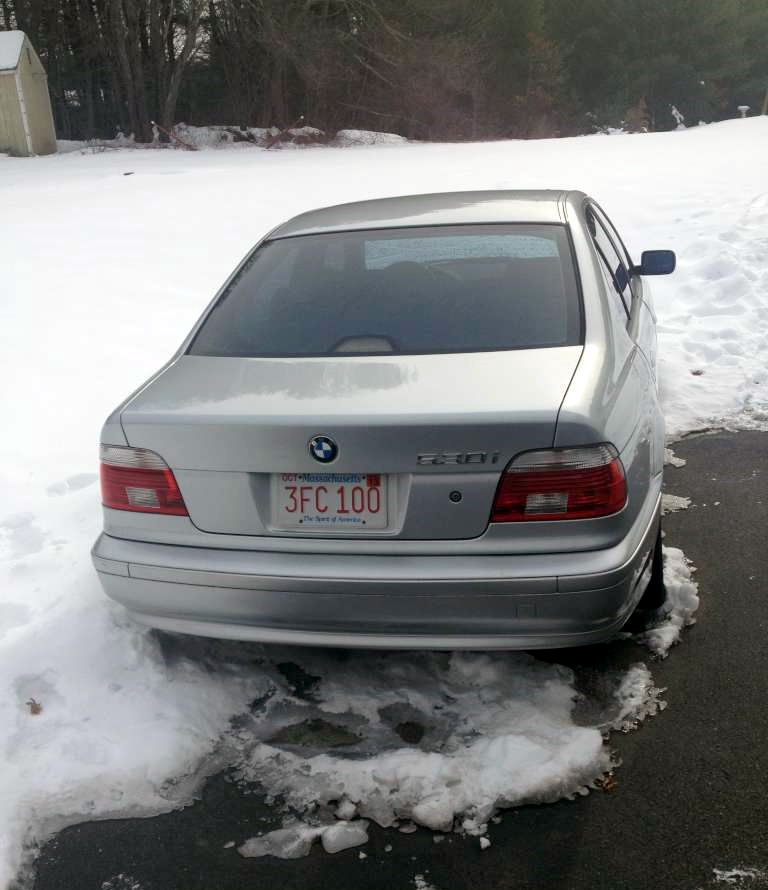
But when I walked around the car, I was, to my surprise, quite impressed by its condition. I didn’t see a dent or a rust spot anywhere on it. In general, the lines of the E39 don’t set my heart a-flutter, but the silver paint and the black Shadowline trim gave the car a nice appearance, marred only by the not-my-taste Beyern wheels whose finish was badly corroded.
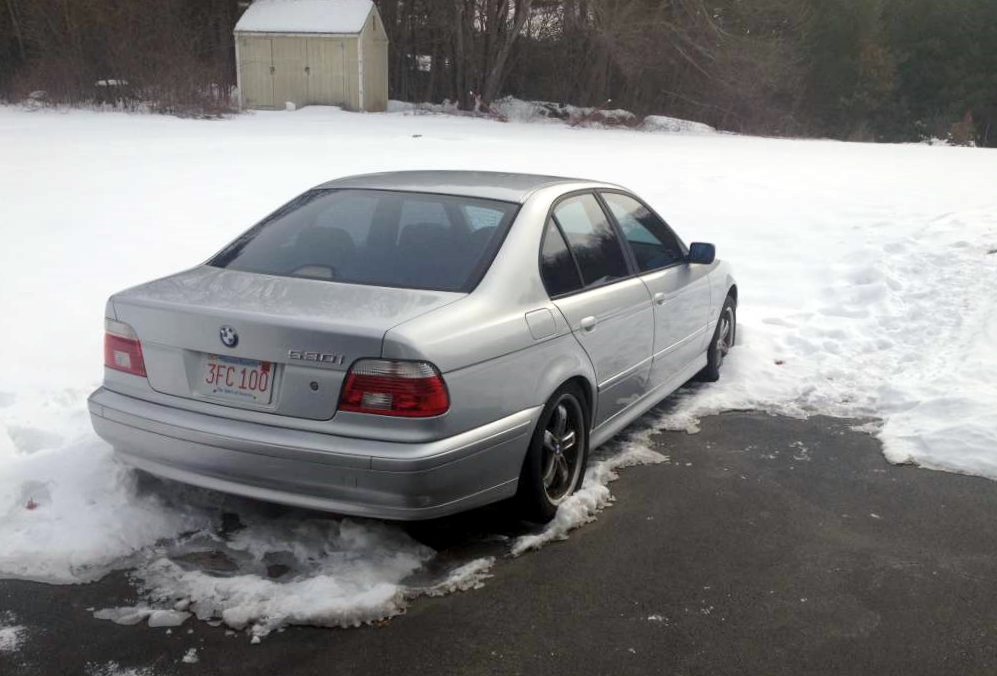

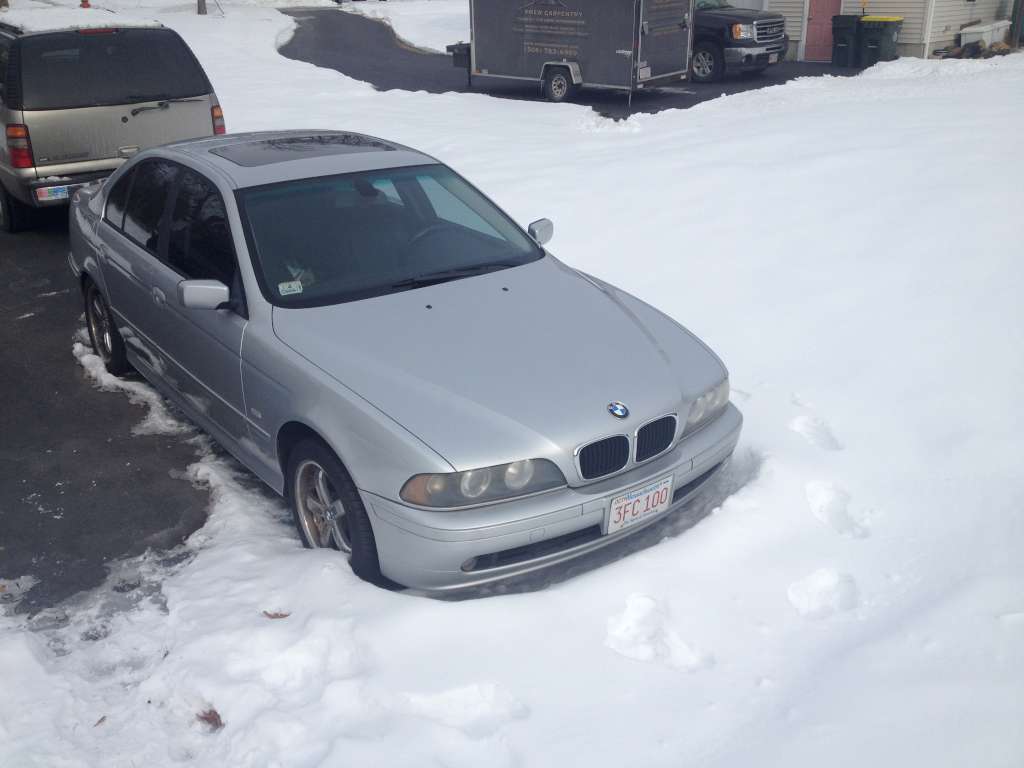
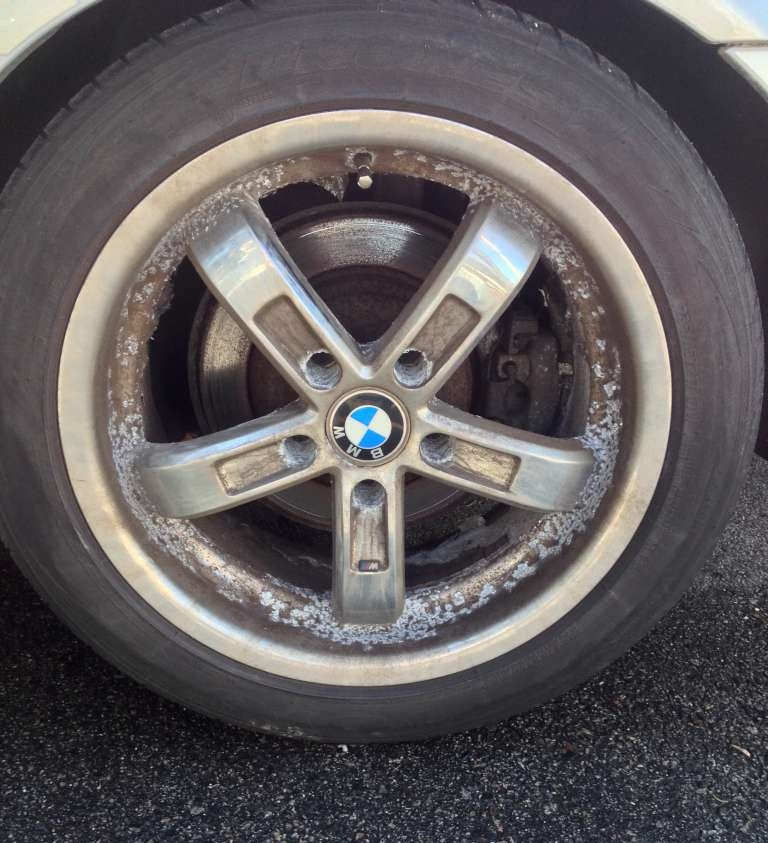
Peering through the window of the car, I saw that the black sport interior appeared to be in really nice shape. The car wasn’t at all what I expected for a 174,000-mile car that hadn’t been started in six months. It looked way better.
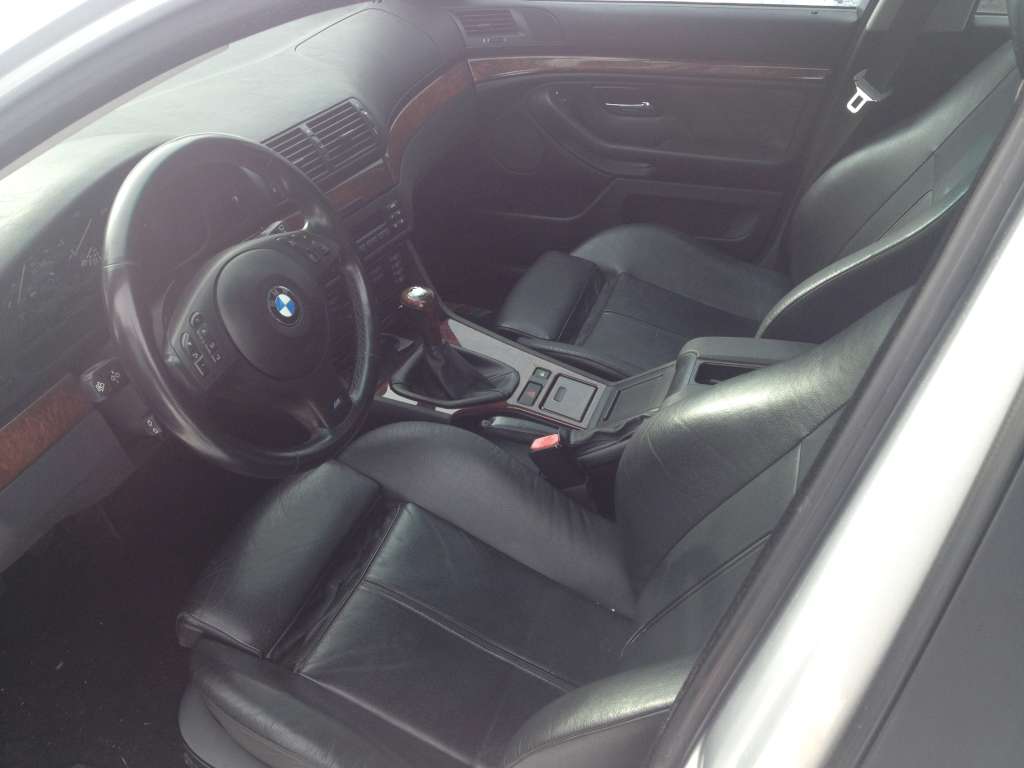
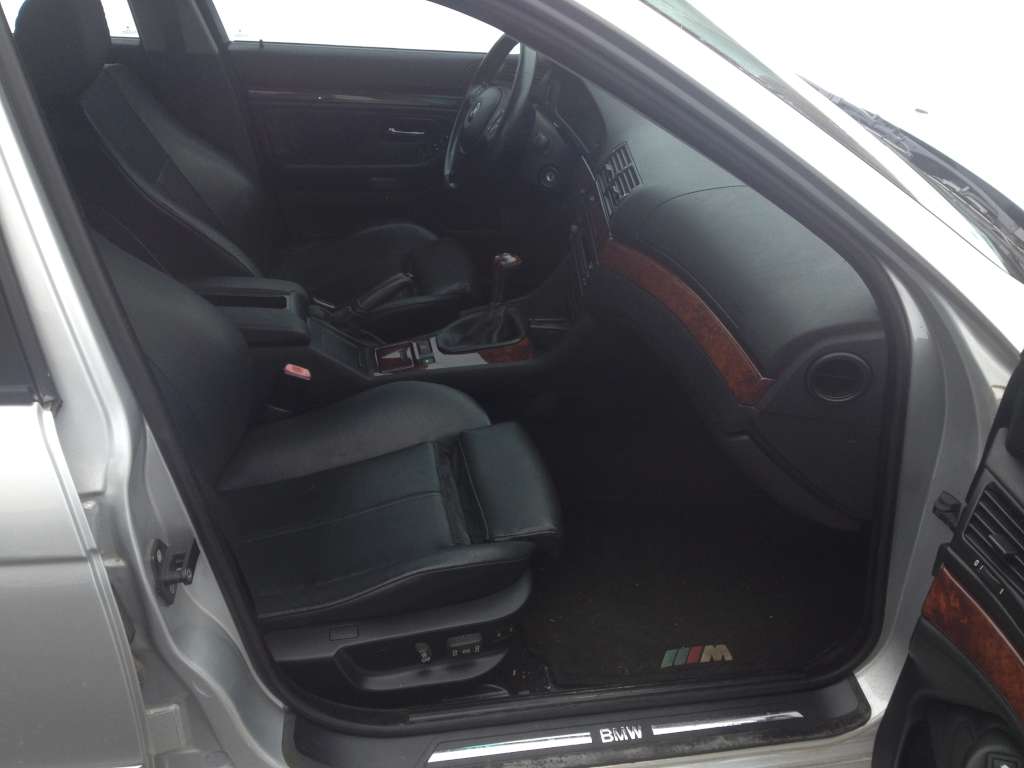
Hmm.
I backed the ’Burb in trunk-to-trunk so I wouldn’t have to lug the battery or the tools any farther than necessary. The seller then appeared in a brand-new high-top utility van. He and another young man, who I assume worked with him, hopped out. The seller explained that he’d just bought the high-top van for his electrical business—another reason why he needed to sell the 530i.
(Pro tip: The combination of a dead car, it being a slightly-less-desirable or less-well-known model, expired tags, and a motivated seller makes for real opportunity. Add in the frigid temperatures and—well, I didn’t see anyone else there looking at the car, did I?)
I asked the seller about the expired tags. He said that the car was in fact registered and insured, but the current registration sticker was probably lost in his office somewhere. He freely admitted that the car hadn’t been regularly driven in about a year and a half, and thus the inspection sticker had expired.
The seller grabbed a shovel and cleared the snow from the left side of the car. He noted that one of the left tires was nearly flat. I popped the hood and saw the requisite leaves, pine needles, and nuts you’d expect in a car that’s sat outside, but wasn’t horrified by the condition of the engine compartment. I verified that the engine had appropriate levels of oil and antifreeze, and that neither contained visible quantities of the other.
I explained to the seller and his friend why their jump-start had likely failed, and what I was about to do: pull the dead battery out and install the fully charged one. As I cleaned the battery terminals and swapped batteries, I gave a running commentary about how no alternator is designed to recharge a completely flat-lined battery, and how, on a modern computer-controlled car, you might be able to get it started with a jump, but dashboard lights may flash, and the car may go haywire and suddenly die due to the voltage levels being wrong because of the high load being placed on the alternator to get the battery voltage up. Better, I explained, to just drop a fresh battery in. (All of which is, incidentally, covered in my next book.)
They listened to what I was saying, but their eyes went wide when I twisted the key and the car blasted to life as if it had been driven yesterday.
I have to admit that I was a bit surprised as well. After all, there’s no knowing why a car has really been parked for six months. I smiled, and noted that no horrible noises emanated from the engine compartment.
While the car was idling, the seller grabbed a compressor and fully inflated all four tires, warning that, with the tires’ worn tread, the car could well be immobilized in his slightly down-sloping driveway by even small amounts of snow. I got in the car, and with the two guys pushing, was able to rock it out of its winter encasement. Initially, both the clutch and the steering were so sluggish that something seemed wrong, but they both quickly freed up.
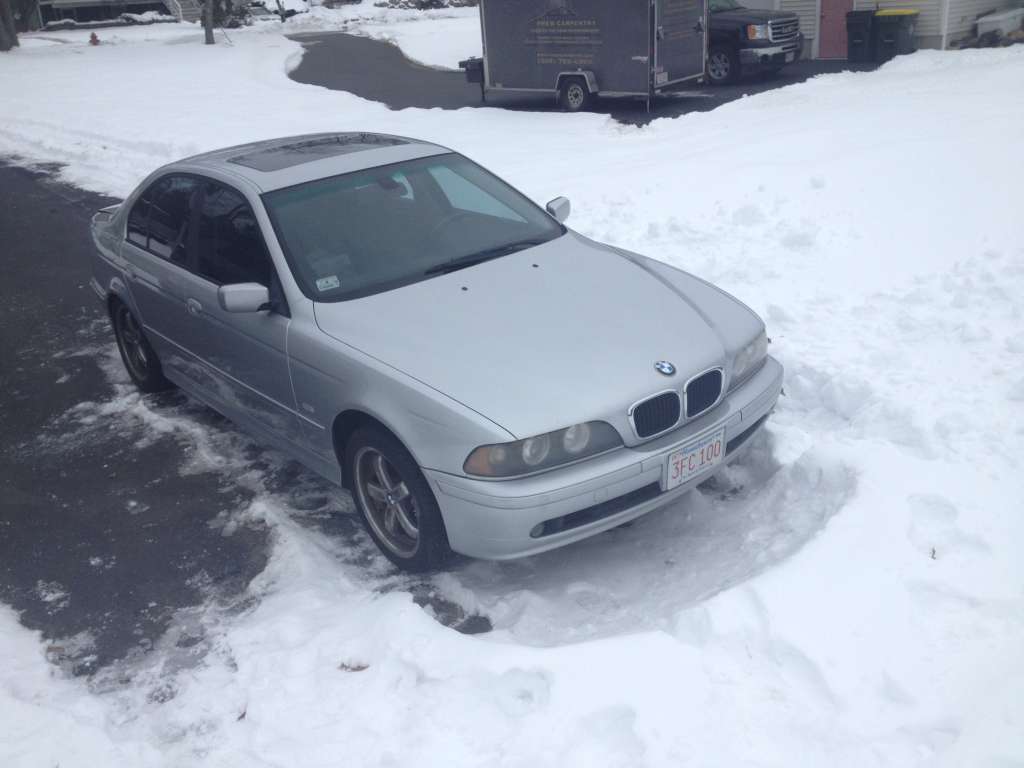
Now, six months is really not that long for a car to sit. You expect flat-spotted tires, and, if the car has been sitting outside, you can figure that the brake rotors have deposits from where the pads have stuck. But hopefully that’s it, and you’re spared the pain and expense that comes from the fuel turning to varnish and the seals in the engine and brake hydraulics hardening and leaking.
All three of us hopped in the 530i and took it for a short drive. Other than the rhythmic kaCHUNK from the flat-spotted tires, the sound of the brake pads scraping rust off the rotors, and the fact that the Check Engine Light (CEL) remained on, there was nothing obviously wrong with the car. It revved up without stumbling or hesitation. It didn’t obviously pull to one side on braking. At one point, I recounted the scene from Rush where Nikki Lauda nails a car when an attractive woman he’d just met asks him to, then gave the car a good punch.
“This thing is awesome,” the seller’s friend said. “Maybe I’ll start a bidding war.”
The seller chided him. “Don’t do that. You don’t know anything about cars,” he said.
It was awesome. And, more than that, I liked the car. In a few minutes, I’d gone from “This will make a great story” to “Damn, this thing is nice” to “I can see myself daily-driving this thing” to “I deserve to be driving something that isn’t a shitbox” to “I would totally rock these black leather sport seats and wood trim.”
Since the car lacked up-to-date registration and inspection tags, I drove it just long enough to see the temperature gauge stabilize midway. I pulled the car back into the driveway, let it idle, lay down in front of the air dam in the cold, and looked beneath the engine compartment. I didn’t see any fluids screaming onto the ground. As I rummaged around in the trunk while wrestling the Z3’s battery back out, I noted that the spare was one of the original Style 42 cross-spokes.
Well, then.
I asked if the car had records. The seller said no, not really, just the most recent work to replace the front struts. I crouched down at the right front wheel arch and could see that the strut cartridges did indeed appear new.
I asked if anyone else had seen the car. No, the seller said; I was the only one who’d come, though he’d had the usual pile of unwanted Craigslist lowball offers. I explained that those are rarely worth the electrons they’re transmitted by, and that buyers, if they come, simply use an accepted lowball offer as the starting point for applying new downward pressure on price (“Oh, when I offered you $800, I didn’t know the CEL was on,” etc).
I was very candid with the seller. I explained that I liked the car, but I didn’t need it. I said that there was risk to me in the fact that I’d just shown him that his dead car wasn’t dead at all, and needed only a fresh battery to be sold as a running car. That is, I’d just spent a morning in the cold doing this, and now he could go buy a battery, install it, and sell it to someone else as a running car for more than I’d offer him. I said that if he wanted to do that, that was his call, I understood he was a young guy with his own business and a young family to watch out for, all is fair in love and car sales, yadda yadda. But I also pointed out that the car was uninspected and the CEL was on, and with Massachusetts’ lemon law, any buyer would be within his rights to return it to him to get it fixed and inspection-worthy, but that I would never do that.
I told him that if he wanted to sell it, I’d give him $1,200 for it right now.
He paused for a moment. “Will you love it?” he asked. “Will you keep it and nurse it back to health like it needs?
“Actually,” I said. “Yes, I believe I will.”
“How about $1,500?” he asked. “That seems fair, doesn’t it?”
And indeed it was. I don’t bargain for sport, or to get down to the absolute lowest number. If an asking price is eminently reasonable, sometimes I don’t bargain at all. $1,500 was the perfect price for both of us. We shook on it, I gave him the cash, and he signed the title over to me on the spot. Done deal.
In truth, I’d been sitting on the cash since passing on the Great White Six-Speed Shark 850i some months ago; it’s a wonder the money hadn’t transmogrified into steel, glass, and rubber until now. Actually, if you think about it, I showed rather remarkable restraint over a period of several months.
I asked the seller to give me a little time to figure out how to get the car home. As I was driving back to Newton in the ’Burb, I turned the options over in my mind. I could pay for a tow, or spend $65 and rent a U-Haul auto-transporter and drag it myself.
Or—gadzooks!—simply drive it.
These days I’m pretty averse to risking law-enforcement entanglement, particularly with a car with expired tags, so if I was going to drive it, I’d need to do it legally and register and insure it. When I got home, I explained what had just transpired to Maire Anne, ending with, “And besides, the story wants to have me throw a battery in the car and drive it home.”
She looked at me and laughed right in my face. “What?” she said. “You’re making a decision on what to do on the basis of how you want the story to end?”
Well, yes—absolutely. The entire Brian Ach affair (my offering to repair his tii that died on the way to the Vintage for free if he brought it to me) started because the story of my not being able to fix it where it died in northern Virginia had the wrong ending.
So I called my insurance agent, cancelled the insurance on the Z3, and transferred the plates to the 530i. Owing to the need to wait for Maire Anne’s and my schedules to align, and my preference for doing such an inaugural drive during daylight hours in case something went wrong, it took until Saturday morning for us to get back out to Bellingham and pick up the car. I threw in another battery, plugged in my OBD-II scan tool, turned the key to ignition, read out only a single misfire code, and cleared it. Other than the outside-temperature warning beeping incessantly and annoyingly (I assume due to a bad sensor), a bit of a musty stale smell coming from the climate-control system, and a steering shake at 45 mph that’s likely due to the flat-spotted tires, all went well. And the Check Engine Light did not re-illuminate on the drive home.
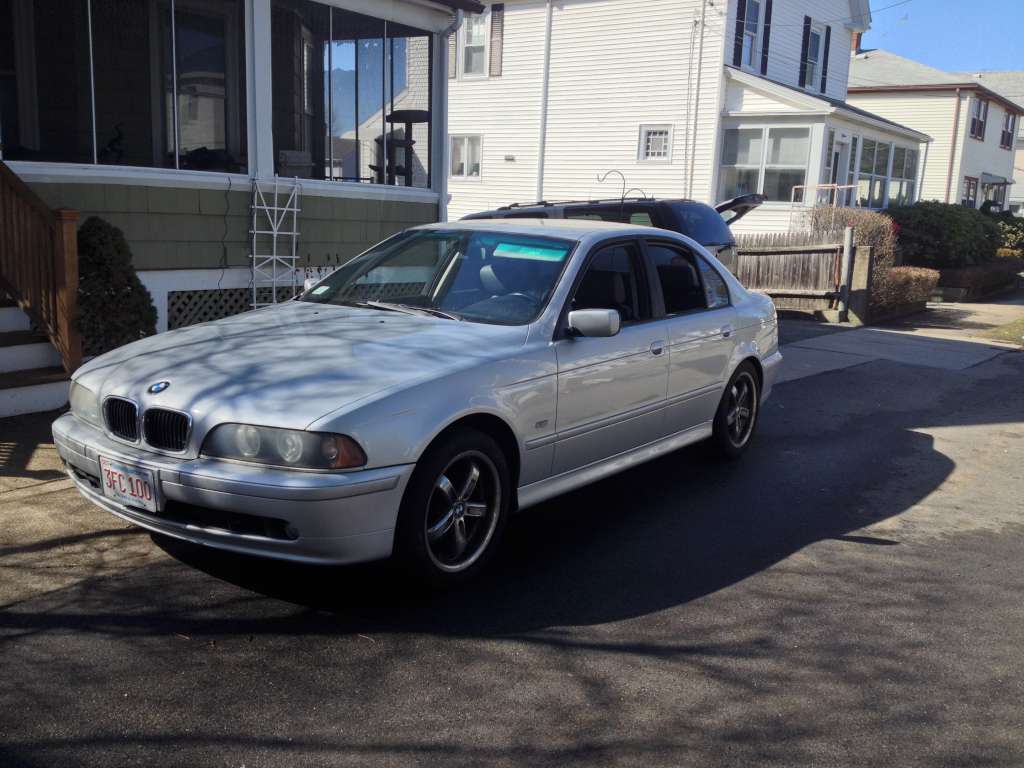
So, good deal? Great deal? Immoral steal? Don’t know yet.
On paper, $1,500 for a running rust-free, dent-free pretty-shiny stick sport-package 2003 E39 530i sure sounds like a steal. But a nationwide CL search shows a fair number of these cars being sold inexpensively. And at a bare minimum, this one needs snow tires to be safely drivable, and come spring, it’ll need fresh rubber. So really, we’re talking two sets of wheels and tires. A proper set of the original Style 42 wheels with good rubber could cost me what I paid for the car. It’s probably best to get the cheapest set of winter wheels with snows (or just snow-shoe the Beyerns) and let Boston’s potholes kick the crap out of them for a few months while I lurk on Craigslist waiting for a good set of warm-weather sneakers. Plus, with the CEL on, the car will almost certainly need something to pass inspection. And, of course, there’s the prophylactic cooling-system maintenance any modern BMW needs. So there is cost ahead.
But the wheels notwithstanding, the car probably cost less than a quarter of what I’d have to pay for the DD I wanted—an E36 M3/4/5—in comparable condition. So I’m daily-driving a BMW again.
And it’s the best wintah beatah evah.—Rob Siegel
Rob’s book Memoirs of a Hack Mechanic is available through Bentley Publishers, Amazon, and Bavarian Autosport—or you can get a personally inscribed copy through Rob’s website: www.robsiegel.com.






